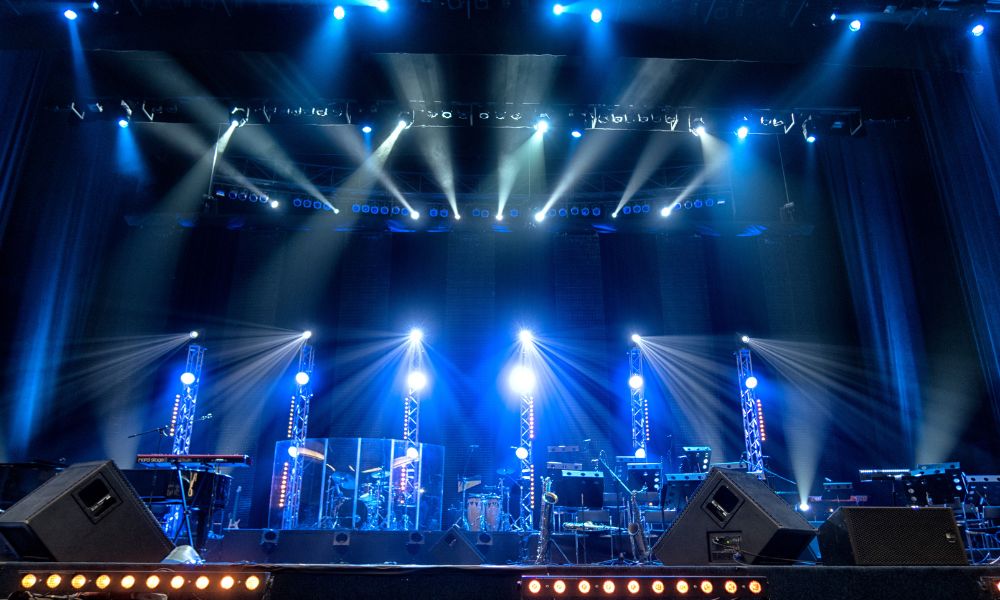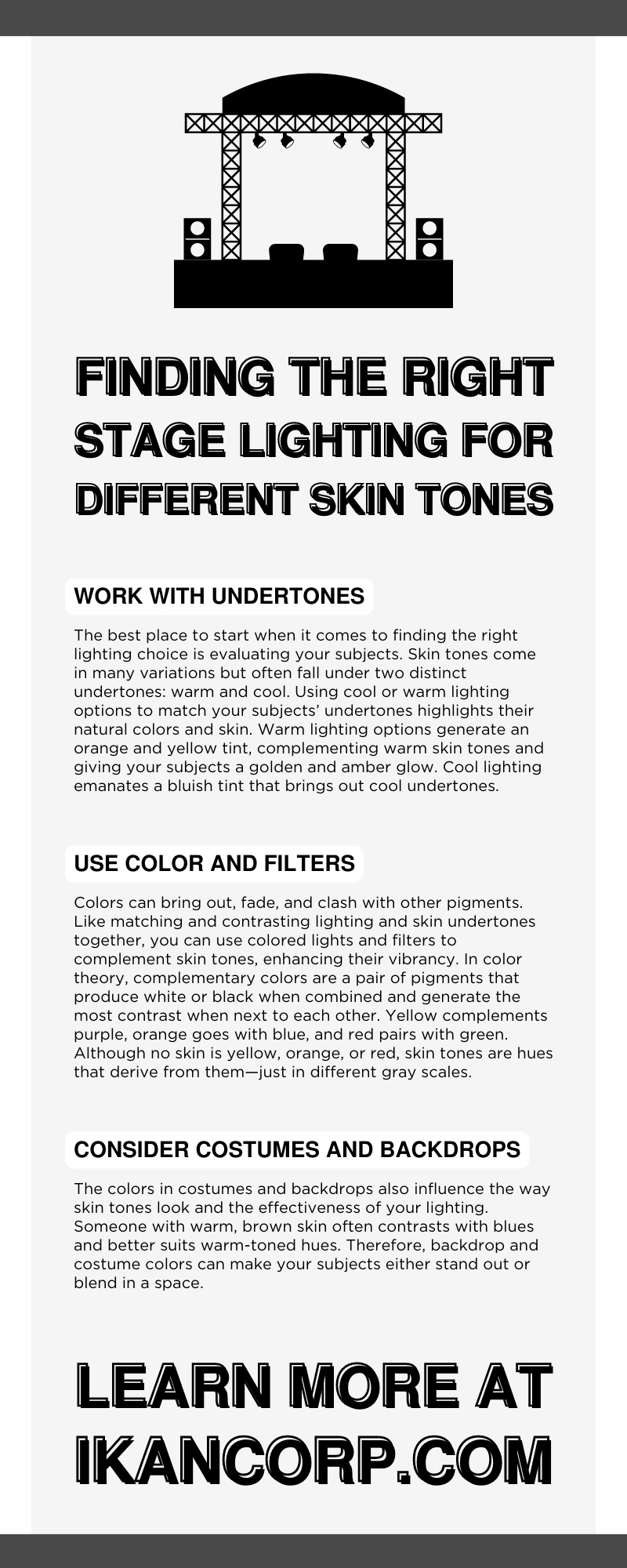 Whether you’re filming a movie or a live performance, your subjects are the focus. Your goal is to highlight them and showcase their beauty and talent. Proper stage lighting does just that—illuminates, defines, and spotlights subjects. However, lighting is a technical and skilled task requiring the right equipment and techniques. There are many different types of stage lights, and it’s crucial you find the right lighting for different skin tones. Illuminating your subjects with the wrong lighting type risks washing them out and adding lots of shadowing and unnatural visuals. Learn how to find the right stage lighting for different skin tones to effectively highlight and capture your onstage talent.
Whether you’re filming a movie or a live performance, your subjects are the focus. Your goal is to highlight them and showcase their beauty and talent. Proper stage lighting does just that—illuminates, defines, and spotlights subjects. However, lighting is a technical and skilled task requiring the right equipment and techniques. There are many different types of stage lights, and it’s crucial you find the right lighting for different skin tones. Illuminating your subjects with the wrong lighting type risks washing them out and adding lots of shadowing and unnatural visuals. Learn how to find the right stage lighting for different skin tones to effectively highlight and capture your onstage talent.
Work With Undertones
The best place to start when it comes to finding the right lighting choice is evaluating your subjects. Skin tones come in many variations but often fall under two distinct undertones: warm and cool. Using cool or warm lighting options to match your subjects’ undertones highlights their natural colors and skin.
Warm lighting options generate an orange and yellow tint, complementing warm skin tones and giving your subjects a golden and amber glow. Cool lighting emanates a bluish tint that brings out cool undertones. Matching and contrasting undertones enhance the natural appearance and vibrancy of colors.
A simple way to determine your subjects’ undertones is by looking at their veins. Typically, people with cool undertones have veins that appear a deep blue or purple color under the skin. Conversely, subjects with warm undertones have green veins. Lastly, a mix of green and blue signifies neutral skin tones. Makeup artists and stylists are also great resources for detecting undertones since their field works closely with colors and color theory. With their expertise and the right stage lighting for different skin tones, you can rest easy knowing how to light everyone in a specific way that works for your unique production needs.
Use Color and Filters
Colors can bring out, fade, and clash with other pigments. Like matching and contrasting lighting and skin undertones together, you can use colored lights and filters to complement skin tones, enhancing their vibrancy.
In color theory, complementary colors are a pair of pigments that produce white or black when combined and generate the most contrast when next to each other. Yellow complements purple, orange goes with blue, and red pairs with green. Although no skin is yellow, orange, or red, skin tones are hues that derive from them—just in different gray scales. For example, pink, peachy pale skin is a lighter derivative of red. Brown and olive skin tones are a darker shade of orange. Honey-colored skin is a shade variation of yellow.
By using the right color theory for skin tones, you can find what the complementary color pairings for your subjects’ skin tones are, and then you can make everything onstage and on-screen more vibrant.
Consider Costumes and Backdrops
The colors in costumes and backdrops also influence the way skin tones look and the effectiveness of your lighting. Someone with warm, brown skin often contrasts with blues and better suits warm-toned hues. Therefore, backdrop and costume colors can make your subjects either stand out or blend in a space.
Your lighting choices can add to the influence surrounding colors have on your subjects, making them brighter or softer and contrasting or cohesive. Taking your subjects’ costumes and the stage settings into consideration helps you find the best lighting solution for your project.
Look for High Color Rendering Index (CRI)
The color rendering index (CRI) is a quantitative measurement of how natural colors appear in artificial lighting compared with sunlight. It determines how accurately a light source can reproduce colors to their true hue.
Capturing and highlighting your subjects’ actual and natural skin tones makes them stand out and look more appealing. Light sources with high CRI offer the most accurate reproduction of true hues. Filters and camera settings can also provide some CRI adjustments, further enhancing the replication of reality onstage and on-screen.
Mix Up Lighting Angles
Angles and placement positions heavily influence lighting effectiveness and results. There are lots of different lighting techniques to explore that play around with varying angles and setups. Where and how the light shines transforms what people see and how subjects look, shifting shadows and highlighting different shapes and colors. Working with your subjects and mixing up lighting placement and angles allow you to find the best way to illuminate the stage without washing out or overshadowing your subjects.
Keep in mind that soft hues and tones often blend easily with their surroundings, requiring more shadow definitions and outlining from lighting. Overall, some skin tones diffuse light while others reflect. Where you place your lighting changes the cast of lights and redefines your subjects’ shapes, hues, and interactions with their surrounding space.
Change Intensity Levels
Lighting intensity affects a light’s cast, influencing how it interacts and looks. High-intensity and harsh lighting forms distinct shadows, erasing and washing out some colors and skin tones. However, harsh lighting also produces a spotlight effect, making your subjects stand out. On the other hand, soft lighting makes certain colors seem flat and dull, but its cast can naturally blend with anything in its reach, making your lighting seem more natural.
In the end, changing your lights’ intensity levels transforms how colors on stage appear. It influences skin tones and the way your subjects attract attention and complements their surroundings.
Conduct Lighting Tests
Whether you switch up the lights’ undertones or mix up the angles, conducting different tests with your subjects allows you to pinpoint the best lighting solution. Every skin tone is unique. Sometimes the best way to find the perfect lighting match is through trial and error. Take the time before a performance or shot to see your subjects on the stage and really explore the multiple possible lighting options available to you.
With TV studio lights from Ikan, you’ll get all you need to find the right stage lighting for different skin tones. Our lights come in many forms, varying in technical capabilities, mounts, and versatility. They allow you to play around with different lighting techniques, enhancing your chances of getting the perfect lighting for different skin tones.
Everybody deserves their moment in the spotlight. Finding the right stage lighting for different skin tones allows you to provide everyone an equal opportunity as the star of the show, diversifying the entertainment industry and beyond. Help people shine onstage and in front of the camera with quality equipment from Ikan and these lighting tips.

